For more than a decade, a group of older Americans has been petitioning their elected officials to correct what they believe is an injustice which they have encountered regarding their Social Security benefits. Simply put, these beneficiaries - all now between the ages of 73 and 77, all born between 1917 and 1921(9)Care convinced that they are receiving less than their fair share of Social Security benefits as a result of changes Congress made to the system in 1977.
As evidence, they point to the Social Security Administration's own statistics that demonstrate that many of these six million or so retirees are receiving benefit payments that are, on the whole, lower than those of other beneficiaries who share similar work histories but were born either before or after them. And, when those benefit levels are displayed on a vertical bar graph, they do, in fact, drop swiftly, then move upward again, creating a kind of v-shaped "notch" which has come to represent what is now known as "the Notch issue" (see Chart 6).
How did this happen?
The Problem of Ad Hoc Increases
The Social Security program is not static; Congress periodically reviews and revises it. Major changes even took place between the time of the program's inception in 1935 and the day when the first monthly benefit payments were made in 1940.
Originally, Social Security was to provide monthly benefits only to aged individuals who had retired from jobs in commerce and industry. Subsequent amendments added new beneficiary categories, including spouses and children of retired workers; survivors of deceased workers; and disabled workers and their spouses and children.
In addition, coverage has been broadened to include new categories of employees, farmers and other self-employed people, and public and non-profit employees. Periodic amendments have also changed rules of eligibility, such as the amount of time worked that is needed to qualify for benefits, the age of eligibility, and how post-retirement work affects benefits.
Most important to the issue before the Commission, however, are the frequent changes that Congress has made to the rules that determine the amount of monthly benefits. Some of these changes were made to accommodate other modifications in the program;(10) most were made, however, to offset inflation's erosion of the purchasing power of benefit payments.
Before 1972, benefit amounts were determined by using a table(11) that related basic benefit amounts to average "covered" wages.(12) Benefits determined from this table would not change unless Congress amended the law.
But inflation routinely ate into the real value of these static benefits. Therefore, from time to time, Congress would revise upward the benefit amounts in the table.(13) These periodic ad hoc increases both restored lost purchasing power for existing beneficiaries, and provided higher initial benefits for new beneficiaries.
Though not widely noted at the time, these new retirees' benefit levels tended to be significantly higher than those of existing beneficiaries. Why? The answer lies in wage growth.
Since both productivity increases and inflation naturally increase wage levels over time, new beneficiaries reach retirement age with higher average wage histories than workers with similar careers who retired earlier. Since the Social Security Administration bases benefits on a worker's wage history, these new retirees qualified for higher benefits as a result of this wage growth. But they also realized an increase whenever Congress increased benefits for those already on the rolls in order to offset inflation.(14)
A Change in Financing
In the early 1960s, inflation was quite modest, averaging somewhat less than 1.5 percent per year. By the late 1960s, however, the rate had more than tripled, to about five percent per year.
In response, Congress acted more frequently than before to provide ad hoc benefit increases.(15) Some observers were alarmed that those increases outstripped inflation; others, meanwhile, were disturbed that retirees' benefits were being eroded while awaiting action by Congress. These two very different concerns coalesced into support for a law change that would provide automatic annual benefit increases determined by an Ainflation index@ based on the Consumer Price Index, or CPI.
With encouragement and support from the executive branch and major interest groups, Congress passed legislation creating such a system in 1972. The new law adjusted benefits annually if the CPI rose three percent or more since the last benefit increase.
Unfortunately, the new law was flawed in that it simply adjusted benefits using the same method Congress had employed when creating previous ad hoc increases. Again, this meant higher benefits not only for those already on the rolls, but for new beneficiaries, who were also benefiting from the growth in their wages. In sum, the new law would result in raising real benefits over time for successive retirees.
The financing of these increases, however, was quite different from the old ad hoc approach.
Financing previously had relied on the safe but unrealistic assumptions that (1) there would be no further benefit increases, and (2) wage levels would not rise. When wage levels did rise, this produced "unanticipated" tax resources, creating a surplus. Aware of how much of a benefit increase it could "afford," Congress then would provide another ad hoc benefit increase, adjusting upward the amount of wages to be taxed in order to take full advantage of increasing wage levels.
Under the new law, benefit increases would occur automatically, as would increases in maximum taxable wages. This meant Congress had to provide financing for them in advanceCi.e., before knowing how much wages would increase. Congress therefore would have to rely on economic projections to determine whether the increased revenues produced by rising wages would be sufficient to meet the increased cost of rising benefits.
In other words, Social Security could no longer use static (and safe) economic projections; it would have to depend on more risky, dynamic projections of future wage and price levels.(16) It would also have to rely on Congress' willingness to act quickly to raise taxes in order to meet the cost of benefit increases if wage growth proved inadequate.
Congress could scarcely have picked a worse moment to move away from the previous, more cautious financing system. The economy defied all expectations in the 1970s, resulting in serious consequences for the financial viability of Social Security.
Benefits Threaten to Exceed Revenues
How could the economy so drastically affect Social Security?
Three economic factors directly affect the financial stability of the Social Security Trust Funds: inflation, wage growth, and employment. As Chart 1 shows, these three factors performed relatively consistently in the 1950s and 1960s, but changed drastically in the 1970s.
Inflation, which drives benefit costs, increased significantly in the late 1960s. But instead of returning to what was then viewed as the more "normal" level of the 1950s and early 1960s, inflation soared in the 1970s, ultimately reaching double digits and averaging close to eight percent over that period.
Typically, high inflation is accompanied by low levels of unemployment. But the 1970s proved to be a decade of "stagflation" during which both inflation and unemployment were high.
This peculiar economic circumstance undermined the financing of Social Security in three important ways: (1) It slowed the flow of taxes into the Trust Funds; (2) it produced rapid increases in benefits, both for existing beneficiaries and for newly retiring workers; and (3) it further increased the amount of benefits paid as older unemployed workers took early retirements.(17)
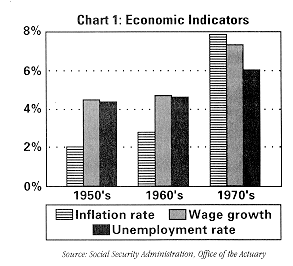
What happened with wage growth? In general, higher average wages are good for Social Security, because more taxes flow into the Trust Funds. But it is not the absolute level of wage growth that is important; it is the relationship of wage growth to inflation that is critical.
As Chart 1 shows, wage growth in the 1950s was more than double that of inflation. In the 1960s, wage growth again outstripped inflation by a wide margin. In the 1970s, however, it actually fell short of inflation.
As inflation drives up benefit costs, wages (and the taxes thereon) must grow to pay for benefits. The adequacy of financing for the 1972 law relied on the assumption that wage growth would continue at a rate roughly twice that of inflation. When wage growth failed even to match inflation in the 1970s, it resulted in a badly under-financed Social Security program.
Unfortunately, this was not a temporary aberration. While inflation was expected to decline, actuaries were no longer willing to make long-range projections based on the assumption that wage growth would outstrip inflation as it had in the 1950s and 1960s. Under these conditions, the method of calculating initial benefits based on a combination of wage growth and inflation inevitably resulted in benefits growing faster than revenues.
For those already on the rolls, the new law worked as expected: Changes in benefit levels reflected inflation. For new beneficiaries, however, initial benefit levels grew faster than wage levels. As a result, the percentage of wages replaced by Social Security benefits would increase from year to year, eventually rising to the point that many new beneficiaries would receive benefits higher than their earnings before retirement - a condition that is as unreasonable as it is unsustainable.(18)
The Problem is Addressed
The bad economic news was quick to arrive. At the time that the 1972 amendments were passed, Congress intended the automatic benefit increase mechanism to be triggered in 1975. But high inflation caused Congress to enact an additional ad hoc increase during 1973, thereby making the need for change evident even sooner. By early 1974, the Board of Trustees of the Social Security Trust Funds reported that the program had a very serious long-range deficit.
Appointed in 1974, the statutory Advisory Council on Social Security devoted its attention primarily to these financial problems. Also, two panels of actuarial and economic experts were convened by the House Ways and Means Committee and Senate Finance Committee to assess the magnitude of the problem and to propose solutions.
While opinions differed regarding the best solution, there was widespread agreement that any solution must include a major revision of the method for determining initial benefits. In addition, it was agreed that measures would have to be found to address other factors such as declining fertility rates, increasing longevity, and an increasing incidence of disability that were so negatively affecting the long-term integrity of the system.
How serious was the situation? By the mid-1970s, Social Security's long-range costs were projected to exceed income by more than 50 percent. Without corrective action, Social Security's funds would be exhausted, and the system would be unable to meet its statutory obligations by the early 1980s.
The Solution: Wage Indexing
By 1976, the need for substantial revisions in the Social Security program and its financing was overwhelmingly clear.(19) In June, the Ford Administration submitted to Congress a proposal to create a new method for determining initial benefits(20) based on an approach called "wage indexing," a method which adjusts a worker's wages to reflect economy-wide changes in wages over his or her lifetime.'' Hearings were held on this proposal, but Congress adjourned for the upcoming Presidential elections before completing a full review.
The new administration of President Carter sent its proposals to Congress in May 1977. Its package included the same "wage indexing" solution proposed by the Ford Administration as well as many new tax and financing proposals.
Despite the two Administrations' support for wage indexing, Congress examined numerous alternative proposals!! in a lengthy series of hearings. Ultimately, both the House and the Senate adopted legislation replacing the flawed 1972 method with a wage indexing method, and President Carter signed these new Social Security amendments into law on December 20, 1977.
These new amendments preserved the way that benefits were adjusted for inflation for those already on the rollsCin other words, existing beneficiaries continued to receive annual increases (COLAs) based on the percentage increase in the CPI. The way initial benefits were calculated. however, was completely revised.
Under the old law, a person's initial benefit was determined by averaging the actual wages he or she earned (in "covered" jobs) over a period roughly equivalent to a working lifetime. A benefit table was then used to determine the basic amount payable.
But since earnings levels in the economy tend to increase each year, initial benefits tended to creep up as the worker's average earnings rose. In addition, these benefits were also "price-indexed" -adjusted for inflation - since the figures in the table rose by the percentage increase in the CPI.
Fixed Formula Introduces Wage Indexing
Thus the old law generated, under some economic conditions, inflated initial benefits by linking, or "coupling," the effect of both wage and price increases. The 1977 legislation "de-coupled"(23) those two elements, substituting a fixed formula for determining initial benefits:(24)
- 90 percent of the lowest range of average indexed monthly earnings, plus
- 32 percent of the mid range of such earnings, plus
- 15 percent of the highest range of such earnings (up to a maximum based on amount of earnings on which taxes are paid).
Like the old approach, this new approach used average earnings over a "working lifetime." But those earnings would now be adjusted ("indexed") to reflect the growth of wages in the economy Cin other words, past wages would be translated into their equivalent in current wage levels.(25)
By adopting this new method, Congress purposely lowered initial benefits to offset the unintended increases that would have occurred as a result of the flawed 1972 method. However, it protected anyone who reached eligibility age prior to 1979Cthat is, anyone born before January 2, 1917 Cby "grandfathering" them under the old law. This protected people already on the benefit rolls as well as those who could have retired in 1978 or earlier but continued working. For those who continued working, the initial benefit calculations resulting from this grandfathering proved especially generous.
Thus a worker retiring under the new law would generally receive lower benefits than a worker I retiring under the old law, which was the intent of Congress. To minimize the abruptness of this change, however, Congress created a special five-year "transitional method" for people who would become eligible for benefits beginning in 1979.(26) In other words, those born between 1917-21 would I be the first to have their benefits calculated under the new law. This "transitional method" was designed to ease their transition to the new, lower level of benefits.
The transitional method was identical to the old method except (1) earnings after age 61 could not be used in figuring benefits, and (2) after 1978, no inflation adjustments would be made until age 62.(27) Individuals eligible for the transitional method would have their benefits computed under the new law method if it produced higher benefits.
The transitional method did not alterCnor was it intended to alterCthe fact that people born after January 1, 1917 would receive, with few exceptions, lower benefits than those born prior to that year. That was the purpose of the 1977 law.
Replacement Rates Are Stabilized
By moving to a system in which initial benefits were tied only to wage growth, Congress made Social Security less sensitive to unforeseen economic changes. It also created a system in which benefits would replace about the same percentage of pre-retirement earnings for future retirees.
This stabilization of "replacement rates" (benefits in relation to earnings in the year prior to retirement) was sorely needed: For a worker who had average earnings and retired at 65, the old law increased replacement rates from 34 to 42 percent between 1970 and 1974.(29) Had the 1977 amendments not passed, that rate would have reached 46 percent by 1979, 60 percent by 2020, and 67 percent by 2050. Replacement rates for low-income workers would have reached more than 100 percent.
As it turned out, those long-range projections substantially underestimated the growth in replacement rates. Under 1994 assumptions, the 1972 method (had it remained in force) would have produced a 70 percent replacement rate for average-wage workers retiring at 65 by the end of this decade.
The objective of the 1977 amendments was to stabilize replacement rates for all future workers with similar earnings patterns, with the goal of replacing 42 percent of an average worker's wages upon retirement at 65, and 35 percent upon retirement at 62Cas always, replacing a higher proportion of wages for workers with below average earnings, and a lower portion of wages for those with above-average earnings.
Charts 2 and 3 show these replacement rates based on earnings in the year prior to retirement (the charts assume individuals have earnings in each year equal to the average wage, and that they retire either at age 62 or 65).
As these charts demonstrate, the new law does, in fact, correct the unintended upsurge in replacement rates created by the 1972 legislation. The transitional method then eases the movement to the desired replacement rate of about 42 percent (for retirement at 65) or 35 percent (for retirement at 62).(30) In Chart 2, the differences in replacement rates between those born in 1917 and those who follow are much less than those presented in Chart 3.
The 42 percent goal represented a reduction of roughly 10 percent from what the rate was expected to reach by 1979,(31) if the old law had applied. The size of the difference between replacement rates generated by the old law and replacement rates generated by the new law would increase over time.
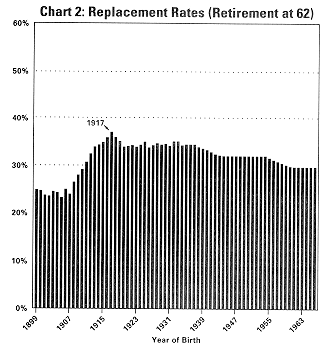
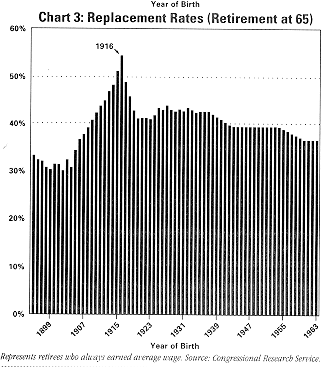
The replacement rate goal of 42 percent has been closely approximated in actual experience as noted in Chart 4 (which also presents the anticipated versus actual growth in Social Security replacement ratios projected to the year 2000).
The new method stabilized the relationship between initial benefits and pre-retirement earnings. Over the long run, these changes made the financing of Social Security more stable as well, since both revenues (taxes) and expenses (initial benefit levels) would be driven by the same economic factor: wage growth. Further, once an initial benefit was calculated, its purchasing power would be kept current through price indexing.(32)
Thus, Social Security was intentionally redesigned to assure that (1) each year's cohort of new beneficiaries began at the same replacement rate relative to their pre-retirement earnings, as beneficiaries in prior years, and (2) their benefits would keep up with inflation.(33)
For some individuals, the new law resulted in benefit increases.(34) But for most beneficiaries who reached 62 after 1978, the new method produced lower benefits than would have been received under the old law (in calculating those benefits, the Social Security Administration always uses the methodCnew law or transitionalCthat yields the highest amount).
For some born between January 2, 1917 and January 1, 1922, the impact of this deliberate move to lower benefits was softened somewhat by the transitional method.(35) As intended, however, that method quickly became less and less effective in limiting the differences in benefit levels generated by the old versus new laws.(35)
Since Congress made the changeover to the new law effective on the basis of birth date and "grandfathered" workers born before 1917 under the old law, two individuals with similar work histories, but slightly different birth dates, could receive substantially different benefits.(37)
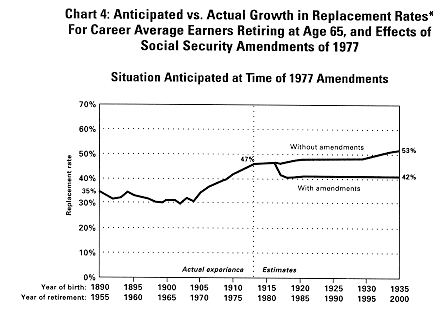
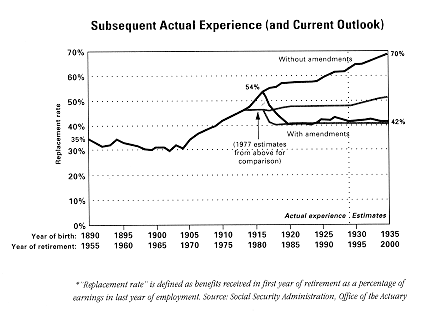
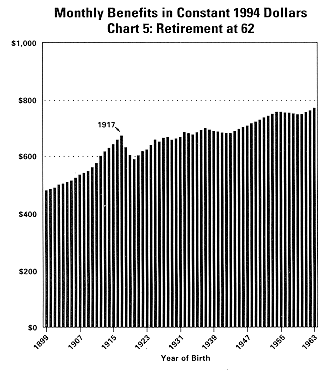
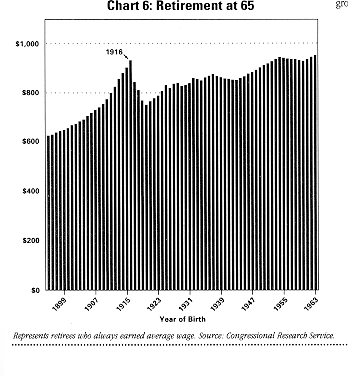
For individuals retiring at age 62, the differences tended to be modest. For those retiring at later ages, however, the differences could be quite large.(38) It is important also to note that for individuals born before 1910, the differences, whether they retire at 62 or 65, are substantial, both in relation to those born between 1910 and 1917 and those born after 1917.
Charts 5 and 6 show benefit levels (in 1994 dollars) for workers who had average earnings every year and who retired at ages 62 and 65, respectively. The drop in benefit levels for those retiring at 65 and born in 1917, coupled with the continuing drops over the next three years, reflect the impact of the new law and the declining impact of the transitional provision.(39) Thereafter, benefit levels begin to climbCprimarily a consequence of the fact that, given a wage-indexed method for computing initial benefit levels and ensuring stable replacement rates, all future beneficiaries will receive a higher benefit base than those born before them, reflecting the gradual growth of earnings in the economy.(40) |